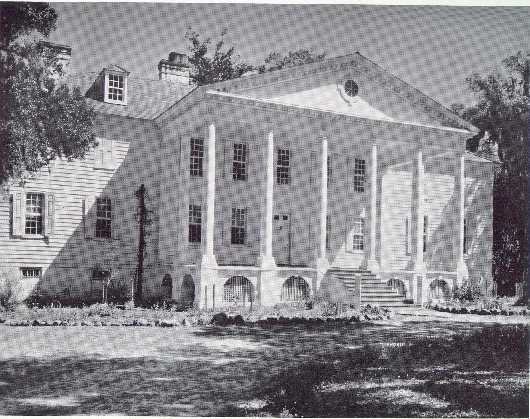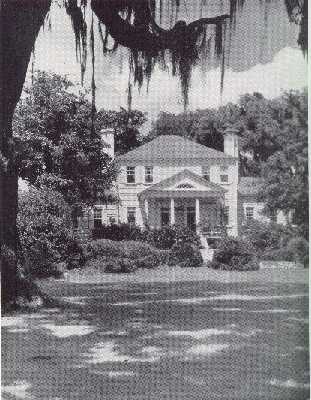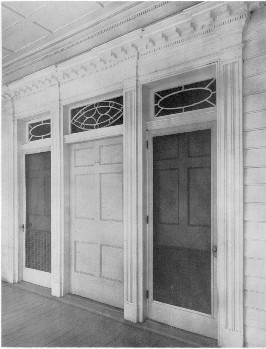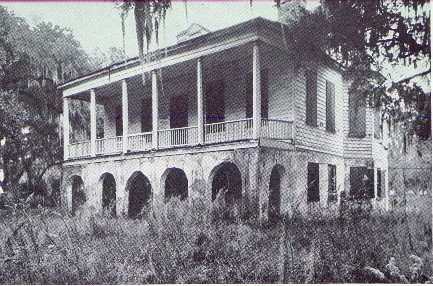
Plantations of the Carolina Coast
Below are four examples of rice plantation homes of varying wealth, time periods, and architectual styles along the South Carolina coast.

Richmond Hill
Richmond Hill was located along the Waccamaw Neck in northeastern Georgetown County on the Waccamaw River between the Brookgreen and Wachesaw plantations. The home was a modest one considering the plantation produced over 400,000 pounds of rice per year at its height and had over 100 slaves. Built shortly after the beginning of the nineteenth century, the house had a brick "pier" foundation of different colored, different sized bricks. This pier foundation was used because bricks had to be produced by the planter or made in Charleston, eighty miles to the south. This means that the house sat on brick columns instead of a typical foundation. The house, owned by Dr. John D. Magill, was about 28 x 32 feet, with a nine foot long front porch. Based on archaelogical evidence, the house was a simple, small one with multiple windows on two levels. There were two chimneys that were each two bricks thick, and the cavity in the middle was filled with sand to support the structure. The size of the brick hearths reveal that the house was not of equal proportions, and the center of the house was the tallest part of it. The upper floor only covered this area, as evidenced by the large brick foundations supporting the house in this area. The picture is an artist rendering of what the house probably looked like.

Source of information is Rogers, pg. 257 and Michie, pg. 71-84. Picture-Michie, pg.85

Hampton
Built in 1735 on Wambaw Creek near the South Santee River in northern Charleston County, Hampton is probably the most impressive of any plantation homes still standing today in South Carolina. Georgian style architecture dominates this house, which has had numerous additions over the years. The home was originally built with four rooms on the first floor and two on the second. It came into the hands of Daniel Huger Horry, a member of a prosporous Hugenot family who then married Harriott Pickney, daughter of Charles Pickney. Horry added an additional two rooms on the second story, including a lavish ballroom. In the ballroom, the walls were made of cypress and a huge fireplace dominated. The other room was a chamber running halfway through the second story. When this lavish mansion is seen, it is of little surprise that this was home to some of the wealthiest and most influential people in South Carolina. It is also of little surprise that George Washington slept here during his tour of the coast in 1790.

Source of information is Stoney, pg 59-60. Picture-Stoney, pg 139. For more information, visit the South Carolina State Parks site and search for Hampton Plantation State Park.

Harrietta
Another plantation on the South Santee River was Harrietta. The house was constructed in 1797 as a home for the daughter of the Horrys of Hampton. However, worked was stopped when the only son of the Horry family decided to move to France. By this time, the daughter had married Frederick Rutledge, and the couple decided to move into Hampton instead of completing the home at Harrietta. It was not until 1858 that Harrietta was finally sold, and the home was finally occupied by Stephen Doar. Even by the early twentieth century not all the rooms had been finished. In the 1930s, a decent staircase was added to the inside of the house and the gardens sculpted. To keep the windows and the doors of the home symmetrical, two doors are built very close together on the garden side of the home. Recognizing that this looked odd, a false door was added between the two. The result of this project is seen below, as well as the house…


Source of information is Stoney, pg. 71-73. Pictures, Stoney, pg 192 and 194.

The Grove
The Grove is located on the Edisto River south of Charleston. The home was built in 1828, and, although fairly small, is notable because of its polygonal rooms, which are seen on the side of the house in the picture. The home has been restored since this picture was taken, but even by seeing this, the unusual style of architecture is apparent.

Source of information is Stoney, pg. 83. Picture, Stoney, pg.227


Front Gates / Table of Contents / Introduction of Rice / Rise of the Rice Plantations / Planters / Slaves / Georgetown County / Geography of Georgetown County / Examples of Plantation Homes / Demise of the Rice Plantations / Gallery of the Abandoned Rice Fields / Explanation of Certain Terms / Links to other sites / Bibliography